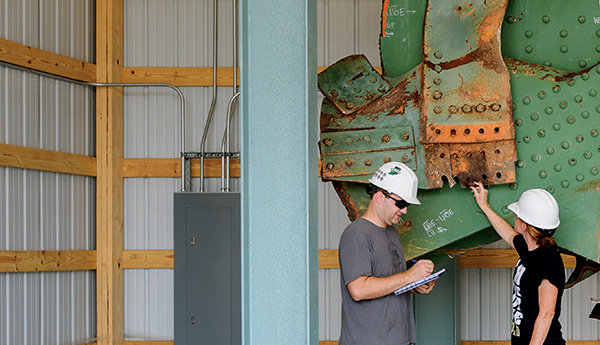Wabash National helps preserve steel infrastructure
As the civil engineers who've designed our current infrastructure begin to retire from the workforce, the next generation of professionals faces a challenge: a knowledge gap.
Purdue provides an answer to this problem with the Center for Aging Infrastructure (CAI). Robert Connor, professor of civil engineering, directs the 22-acre center and its current tenant, the Steel Bridge Research Inspection Training and Engineering Center (S-BRITE). The CAI is home to infrastructure components from all over the country that have been removed and replaced — including three full-scale bridges.
"No one else has done this in the world," Connor says. "Structural and civil engineers are very tactile, and they want to see and touch things. I could lecture all day, but when you walk up to it and see it — wow — it makes sense." The parts collection is instrumental to his teaching about failures and helps him demonstrate to new engineers the functionality of infrastructure designed with older technology.
Now, the CAI is advancing its capabilities. Thanks to generous support from Wabash National Corp., the CAI has a structure to house its unique specimens.
The 60-by-40 foot building — a forensic specimen observation gallery — opened in 2018 and holds special bridge components that have been extracted from failures or damage. The enclosed space protects the components from the weather and further degradation, giving them a longer life span as teaching and research tools.
"Wabash is glad to partner with the Lyles School to develop the Center for Aging Infrastructure," says Robert Lane, vice president for product engineering for Lafayette, Ind.-based Wabash National Corp. "We believe it's crucial that student engineers learn not only from experienced engineers, but also from the infrastructure itself. As a transportation company, Wabash National depends on safe roads."
The first component to reside in the new building is one of the joints that caused the 2007 failure of the I-35W Mississippi River bridge in Minneapolis. Because Connor was involved in the inspection of the bridge following its collapse, he obtained this key specimen, making S-BRITE the only organization with those bridge pieces on display.
Hanging from steel beams, the torn and bent parts on display reveal the joint failure. The bridge, which was built in 1967, was under-designed, Connor explains. He points to the 1/2-inch gusset plate, which should have been a full inch thick.
Connor says the center is grateful for Wabash National's support. "It's been fantastic," he says. "It's unique because they're a transportation company. But I believe they recognize that they're players in this, too. They want to make sure the nation's infrastructure is safe."
Wabash National's Lane says, "We can't take safe roads for granted. Supporting the Lyles School and the CAI is our way of helping ensure the future health of our transportation system."
The CAI holds tremendous possibilities. And though S-BRITE is the primary user of the facility, other groups intend to make use of it, too, such as the Indiana Local Technical Assistance Program, faculty from the Purdue Geomatics group and individuals from other universities. In addition, Connor has received numerous inquiries from other researchers and entities who plan to use this unique facility, such as members of the railroad industry.
"It's a neat sandbox," Connor says. "The ability to use the same specimens, like an entire bridge for example, for completely different purposes by different groups of people with different objectives is going to lead to some really innovative collaborative efforts. In fact, it already is."


